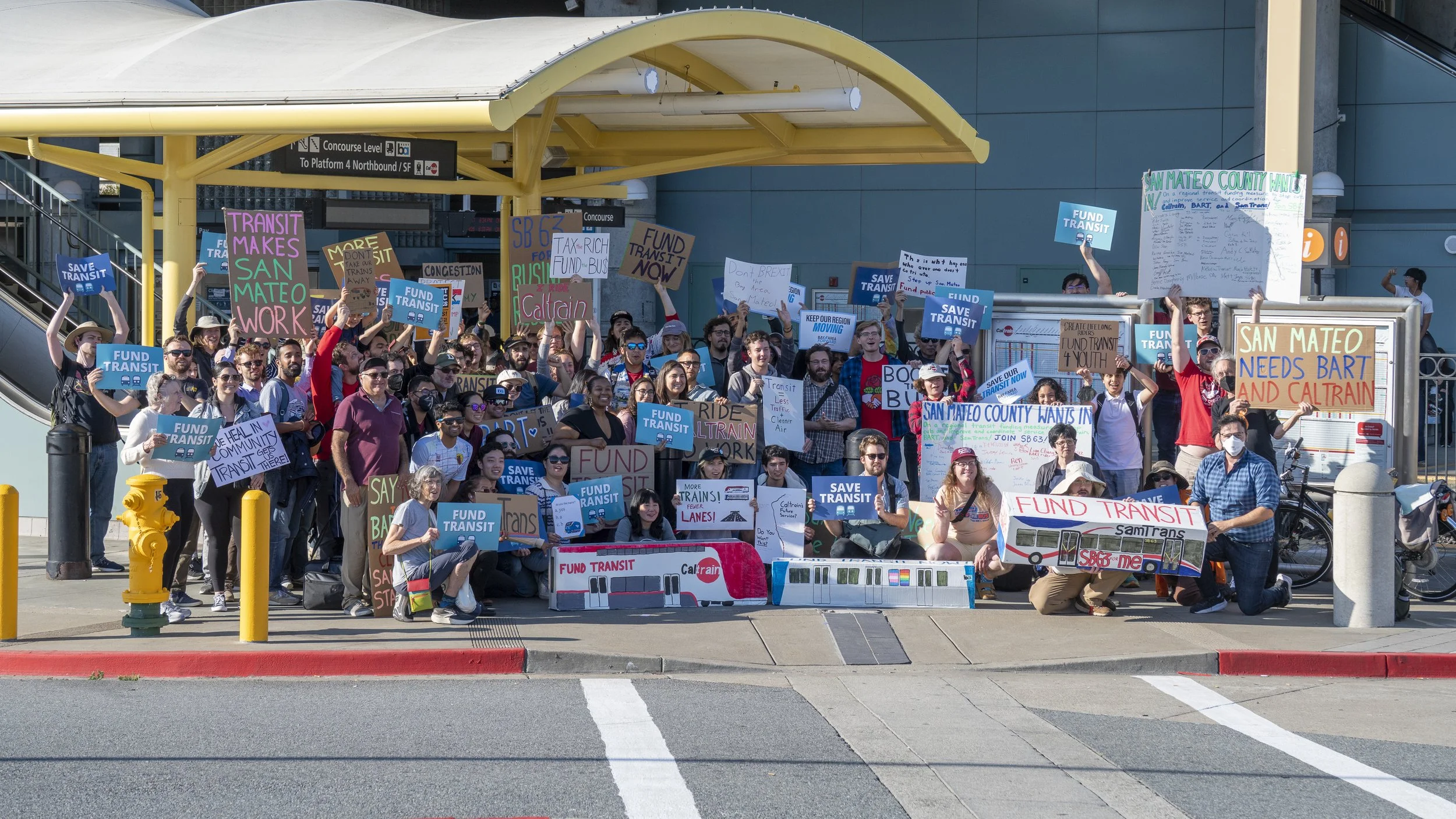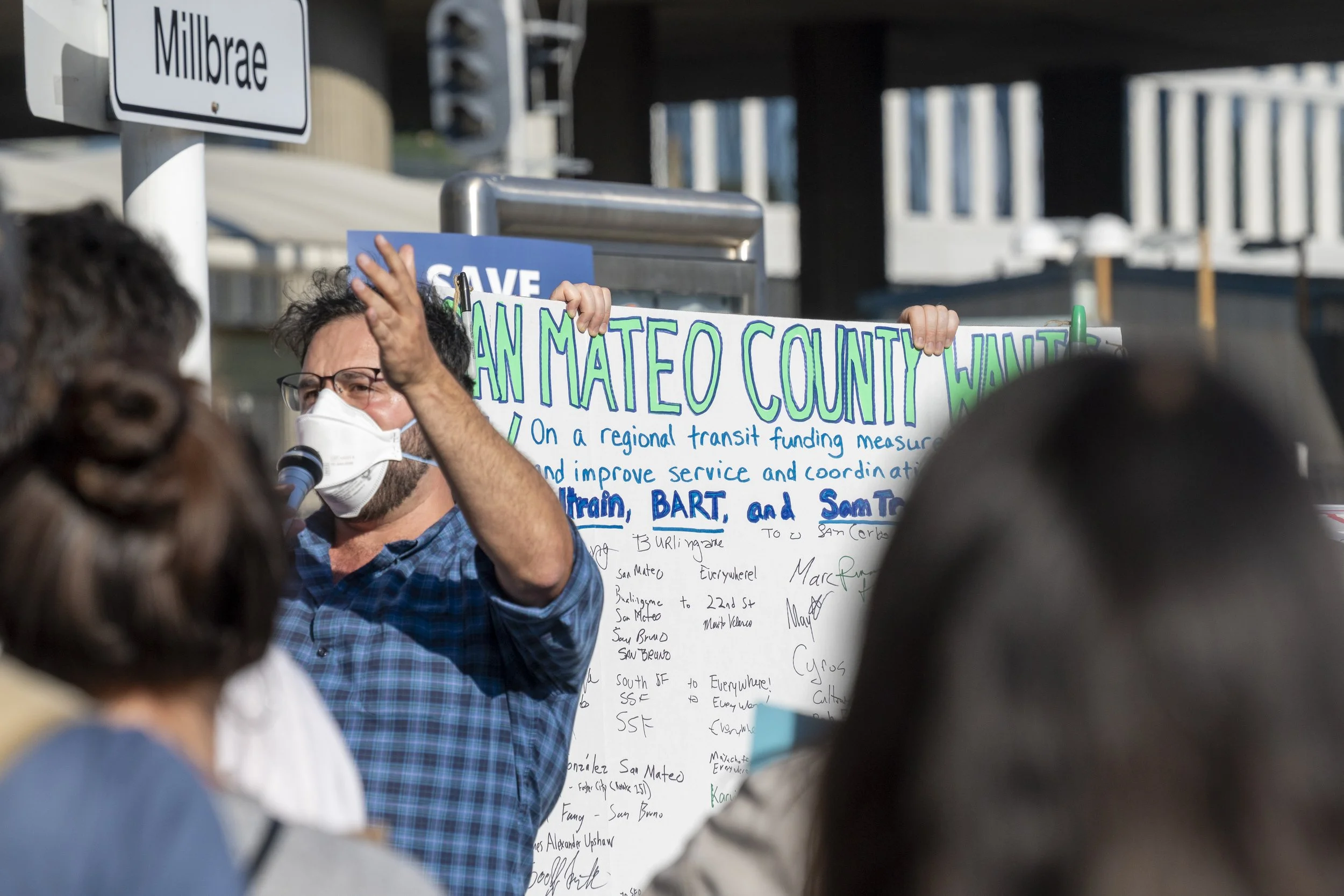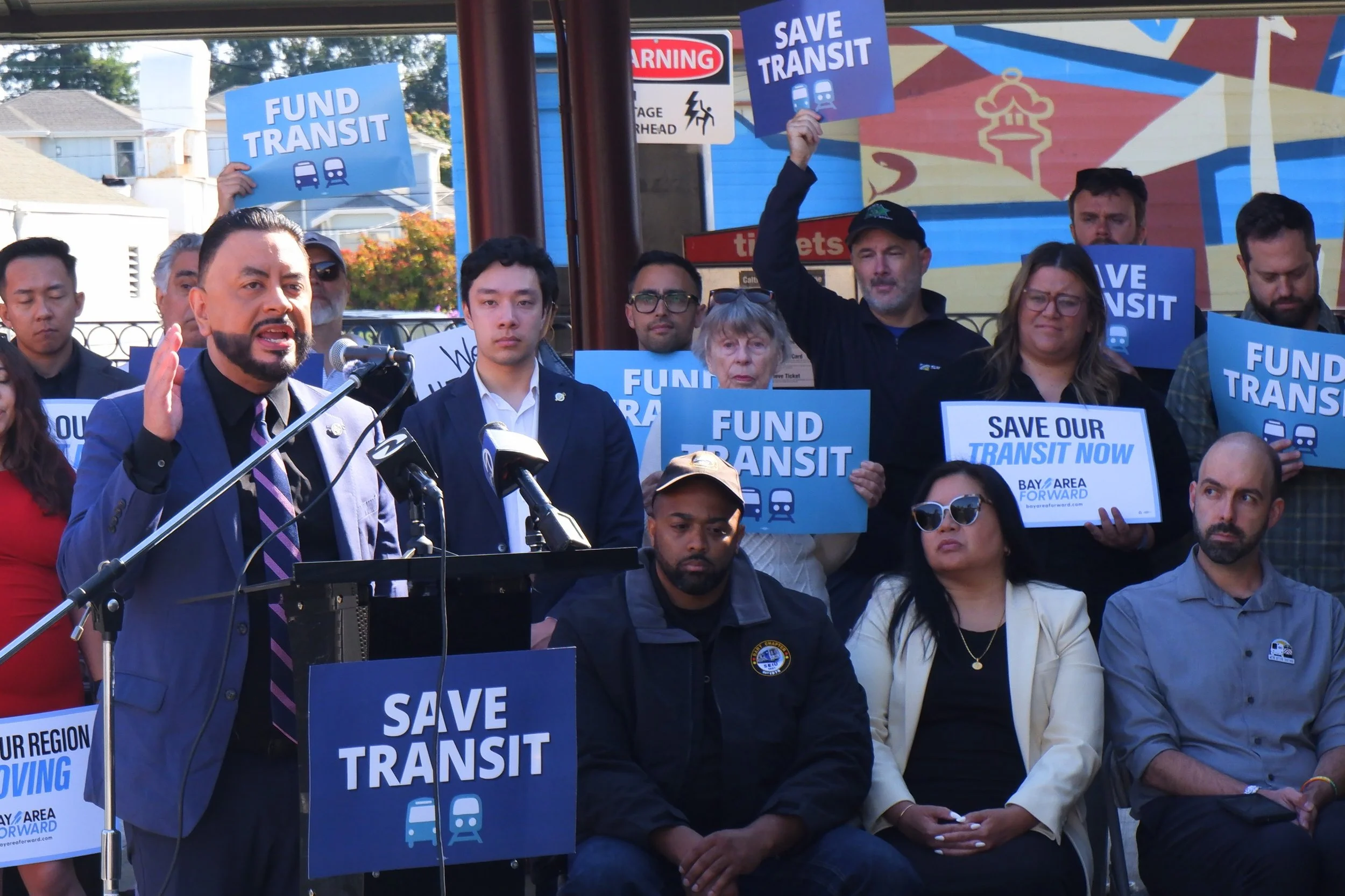Pressure builds on San Mateo County to join the transit regional measure to prevent cuts and improve service for Caltrain, BART, and SamTrans
Last week, a series of events showed public support for San Mateo County leaders to join the regional transit funding measure to save public transit from dire service cuts and improve regional coordination.
Rally organized by transit riders and advocacy organizations
On Tuesday July 1st, transit riders and advocacy organizations gathered at Millbrae Station at the Rally to Save BART and Caltrain in San Mateo County.
"We need long-term, durable funding for public transit to make sure Caltrain keeps running,” said Carter Lavin, co-founder of Transbay Coalition. "San Mateo County elected leaders are getting really close to making a go or no-go decision. The train is leaving the station so we need elected leaders to realize they got to get on board. So we are here to say ‘fund the bus, fund transit, keep the region moving, get on board, we want in!’”
Carter Lavin, co-founder of Transbay Coalition speaking at Tuesday's rally.
“In order to meet our affordability, climate, equity, and economic prosperity goals we need dramatically improved transit service in San Mateo and the Bay Area as a whole,” said Adina Levin, Seamless Bay Area's Executive Director at the July 1st rally. “Transforming Bay Area transit into a convenient, integrated, and world-class system that can attract more riders will require San Mateo County to join the regional transit measure.”
“I urge the SamTrans Board of Directors to opt San Mateo County into the regional transit funding measure,” said Mike Swire, a volunteer advocate speaking on behalf of 350 Silicon Valley. “Failure to do so would be disastrous for the climate, air pollution, and equity. Cuts to transit service would force more commuters into cars, increasing greenhouse gas emissions. Transportation is already the number one source of emissions in the County. More cars would also mean more air pollution, especially in the lower income, diverse neighborhoods adjacent to US 101. In San Mateo County, we have $1 billion in taxpayer funds planned up for widening highways. If we are serious about reducing auto congestion, fighting climate change, and decreasing air pollution, we need to instead be funding convenient and reliable transit service for San Mateo County residents."
Mike Swire, volunteer advocate speaking on behalf of 350 Silicon Valley at the rally.
The rally was co-organized by advocacy groups including Seamless Bay Area, Transbay Coalition, Housing Leadership Council of San Mateo County, Peninsula DSA, 350 Silicon Valley, Silicon Valley Bicycle Coalition, Faith in Action Bay Area, Friends of Caltrain, and Sustainable San Mateo County.
Local elected officials voice support for regional measure
The previous day, on June 30, San Mateo elected officials held a press conference at the San Mateo Caltrain Station on June 30th, voicing strong support for the County's participation in the regional funding measure.
South San Francisco Mayor Eddie Flores speaking at the June 30th press conference.
“Public transit isn’t just a convenience for San Mateo County residents. It connects people to their jobs, education, healthcare, and opportunity,” said South San Francisco Mayor Eddie Flores, at the June 30th press conference. “Whether you’re a student in Daly City, a worker commuting to biotech jobs in South San Francisco, or a senior visiting family in the East Bay, you deserve a system that works and doesn’t leave you stranded.”
“Investing in San Mateo County’s public transit is about protecting essential service and making sure our residents, especially those who depend on transit the most, aren’t left behind,” Supervisor Noelia Corzo said at the June 30th press conference. “Joining the regional transit measure is the best way forward for San Mateo County not just to secure funding, but to ensure our values and priorities are reflected in the regional transit system we’re strengthening together.”
The June 30th press conference was convened by San Mateo County elected officials including South San Francisco Councilmember James Coleman, Supervisor Corzo, Board of Supervisors President David Canepa, South San Francisco Mayor Flores, Redwood City Councilmember Chris Sturken, San Mateo Deputy Mayor Adam Loraine, and Foster City Councilmember Phoebe Shin Venkat.
SamTrans board members lean toward joining, with new polling results and public comment
Then on July 2nd, new polling results showed the majority of Peninsula voters would support a regional measure, and dispelled misconceptions held by some board members about San Mateo County lack of voter support for saving the regional transit system.
At that meeting, over 20 public comments from community members, including people galvanized by the rally and transit workers, spoke in favor of joining the regional measure.
The data and the drumbeat of public support drew more SamTrans board members to lean towards joining the regional measure.
San Mateo and Santa Clara Counties have a month to decide whether to join
Leaders in San Mateo County - and Santa Clara County - have until August 11th to “opt-in” to be included in legislation to authorize a regional transit funding measure in 2026. The measure includes San Francisco, Alameda, and Contra Costa Counties by default. Here is a more detailed timeline for the opt-in decision making process.
The funding measure would prevent dire service cuts resulting from upwards of $900 million in cumulative annual budget shortfalls beginning in FY2027. The pandemic created major financial challenges for agencies. While transit ridership has steadily increased on agencies like Muni, AC Transit, BART, and Caltrain, ridership is still considerably lower than pre-2019 levels, ranging from 45-80% recoveries.
To address this challenge, Senator Scott Wiener and Senator Jesse Arreguín introduced the Connect Bay Area Act (SB 63) earlier this year to create a new, sustainable revenue source to fund our region's public transit service. And the regional measure will be much more successful if it includes all five counties served by the region’s backbone rail services, BART and Caltrain.
Sign up here to get our blog posts sent directly to your email.





